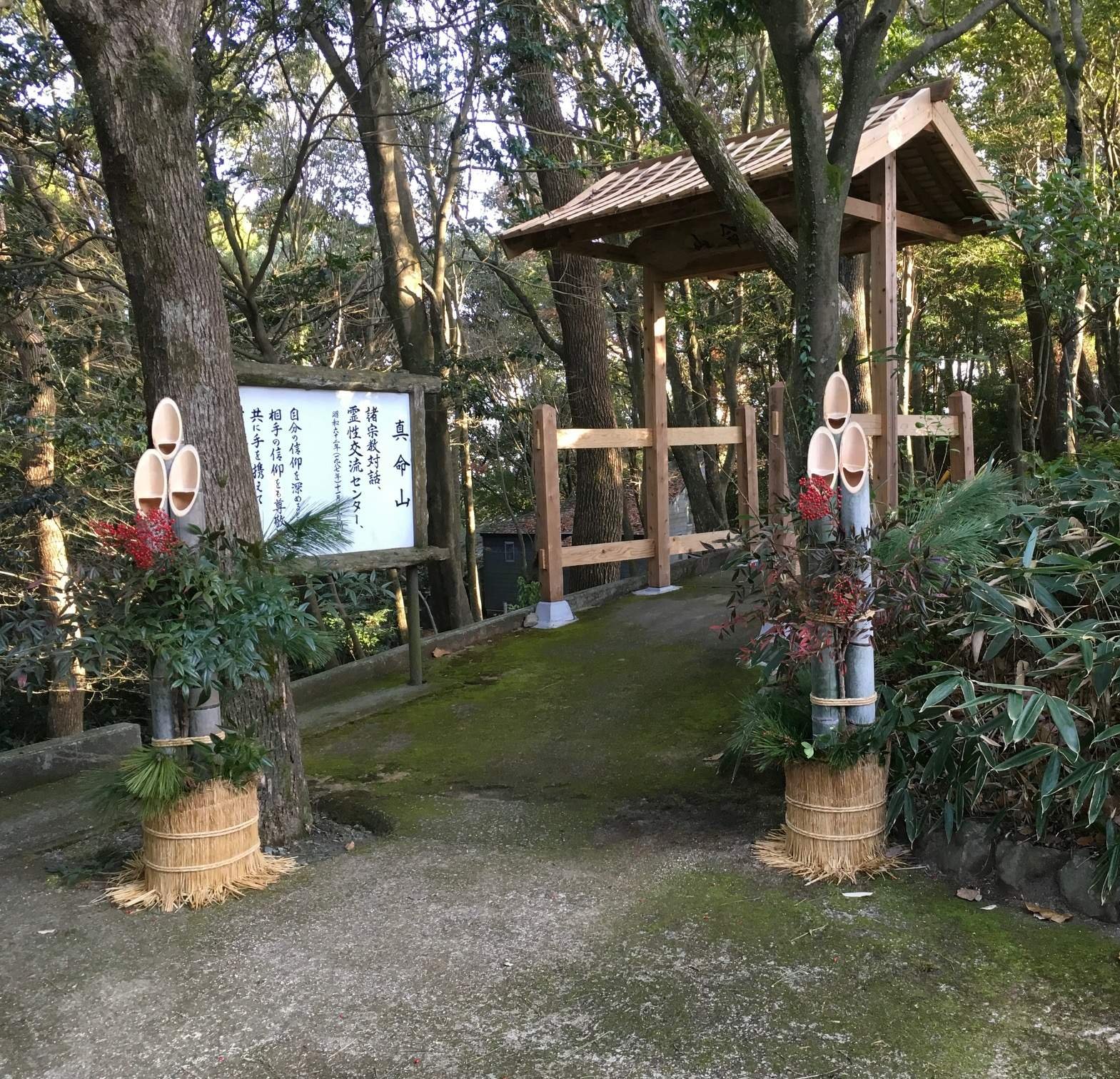GENNAIO 2018 : CAPODANNO
AND MESSAGE TO FOLLOWERS OF SHINTO
SHINMEIZAN: GENNAIO 2018
Per quasi due terzi della popolazione, il mese di gennaio inizia in Giappone con la visita ad un tempio, solitamente un tempio shintoista. Ornamenti caratteristici di questa ricorrenza sono i kadomatsu eretti all’entrata di templi, luoghi di pubblico interesse o, anche, di case private; i shimenawa appesi ad un arco o all’entrata di un tempio, o anche alla porta di casa, o davanti all’automobile! – e così pure i kagami-mochi, deposti come offerta su una specie di ‘altare’, o semplicemente in un luogo distinto, come ornamento, anche nella casa.
Una immagine può farli conoscere meglio di qualsiasi spiegazione. Ecco qui i kadomatsu, shimenawa e kagemochi, che hanno ornato Shinmeizan anche in questo inizio d’anno. Certo questi ornamenti, connessi alla Tradizione Shintoista, anche se attualmente ritengono solo una valenza culturale, non sono solitamente usati nelle chiese cristiane, ma Shinmeizan, come ‘Centro di Dialogo Interreligioso’ li ha adottati fin dall’inizio come ornamenti per accogliere quanti vengono, Cristiani e non Cristiani, per la tradizionale visita di capodanno (hatsumode).
Anche quest’anno la celebrazione eucaristica è stata celebrata di buon mattino per permettere, a quanti vi partecipano, di uscire poi all’aperto, e rivolti verso Est attendere e celebrare il sorgere del sole, momento molto caro ai giapponesi e vissuto come uno speciale rito di inizio d’anno.
Quest’anno le nubi, colorate dal rosso dei riflessi del sole nascente, ne hanno sostituito la visione, ma non hanno impedito agli ospiti presenti di unirsi a noi per la preghiera: Lettura di Giovanni 1, vv. 1-5.18, seguita dal canto del salmo 19, vv. 1-7 e dal canto del Benedictus. Così come non hanno impedito ad amici e conoscenti, e alla gente del nostro villaggio e dei villaggi vicini di venire per hatsumode, la visita al tempio nel giorno di capodanno.
Una attività di dialogo interreligioso che da vari anni ci impegna in occasione del Capodanno è l’invio ai nostri partners di dialogo shintoisti, responsabili di templi o di organizzazioni dello Shinto, del messaggio che il Pontificio Consiglio per il Dialogo Interreligioso rivolge ai seguaci dello Shinto in occasione dell’Anno Nuovo. Contemporaneamente, facciamo pervenire copia del Messaggio anche a tutti i Parroci della Diocesi di Fukuoka, in cui Shinmeizan è inserito, perché ne facciamo occasione di una visita, un saluto, un contatto con i templi shintoisti della loro zona.
Per conoscenza di quanti seguono le nostre attività di dialogo interreligioso, uniamo il Messaggio a questa nostra breve cronaca, augurando a tutti gli amici di Shinmeizan un anno di impegno a servizio della pace nel mondo intero, specialmente attraverso un dialogo fecondo tra le varie tradizioni religiose.

KADOMATSU - 門松

SHIMENAWA - 注連縄

KAGAMIMOCHI -鏡餅

Una delle famiglie in visita a Shinmeizan per il Capodanno

Bimba in abito tradizionale per la visita di capodanno
PONTIFICAL COUNCIL FOR INTERRELIGIOUS DIALOGUE
MESSAGE TO FOLLOWERS OF SHINTO : year 2018
"Christian and Shinto Followers Together: Facing the Challenge of Generation Gap"
Vatican City
Dear Shinto Friends, 1. The Pontifical Council for Interreligious Dialogue sends you warm greetings and best wishes for the beginning of a New Year, a celebration for all Japanese and in particular for the followers of Shinto. On this joyful occasion, the customary visit to a Shinto Shrine will bring millions of visitors, including many young people.
- This year in our greetings, we would like to reflect together on the growing differences between generations which today present notable challenges. The Catholic Church is organising a world-wide consultation entitled “Young People, the Faith and Vocational Discernment” in October 2018. The Preparatory Document for this meeting notes that “Today’s generation of young people live in a world which is different from that of their parents and educators. Economic and social changes have affected the gamut of obligations and opportunities. The aspirations of young people, their needs, feelings and manner of relating to others have changed as well” (n. 2). It further underlines that “In this context, the old approaches no longer work and the experience passed on by previous generations quickly becomes obsolete” (n. 3).
- Clearly the generation gap is deep the world over, but especially in the more developed countries such as Japan. This is marked by older and younger people who have difficulty understanding each other because of their different experiences, opinions, habits, and behaviour. The seeming division among the different generations also contributes to a common problem that increasingly afflicts every generation, namely loneliness. Parents and children can hardly find time together due to the fast-pace of modern lifestyles. The growing lack of communication and interaction among people weakens bonds between generations which were previously the means of passing on the cultural and religious heritage, as well as the wisdom of elders to future generations.
- Dear friends, we have a common concern and task to bridge this generation gap. By experience, we know that leaving an inheritance of economic prosperity to the next generation will not alone guarantee either happiness or a world of justice and peace. What we have is a real treasure needing to be transmitted to the next generation, that is the spiritual inheritance of our respective religious faiths. The threats to peace that presently trouble our world, which the new generation will be called to face, will not be resolved by military confrontation and hostility, but only by the wisdom and the power of dialogue, patience and magnanimity. This is the spiritual heritage that we ought to pass on to the next generations.
- Pope Francis encourages youth to cultivate close relationships with their grandparents and with those who are older. He encourages them to listen to the elderly who have the wisdom of life. He also points out that the grandparents themselves need to listen to the young in order to understand their aspirations and hopes (cf. radiovaticana.va/news/2016/12/19). Thus, each generation can foster and support the other through close interpersonal communication.
- In the end we are human beings who are in essence relational and in need of meaningful contact with each other. Thus, the best antidotes to an ever-widening generation gap are love and understanding expressed in face-to-face interactions or even via digital media which can be an opportunity for meaningful relationship when done in such a context.
- May the festivities of the New Year be a happy occasion where young and old come together to rediscover their religious and traditional cultural values, bridging any distance between generations. May the joint efforts of Christians and the followers of Shinto world-wide truly help bring old and young to recognize the gift of one generation to the other, strengthening society. With this common wish, we offer our cordial greetings once again to you, your families and to your communities.
Happy Oshogatsu to all of you!
Cardinal Jean-Louis Tauran President
Bishop Miguel Ángel Ayuso Guixot, MCCJ Secretary
 English
English  日本語
日本語  Italiano
Italiano 
